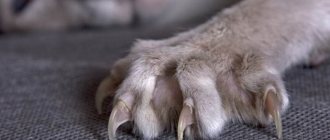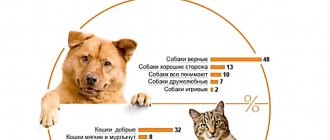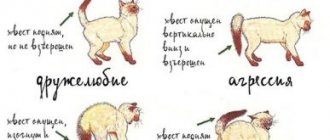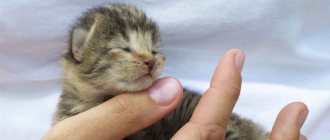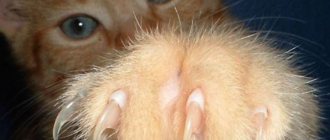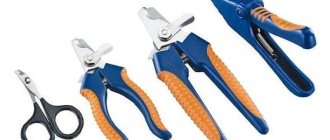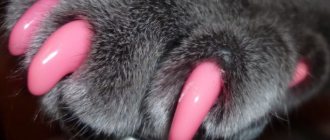Why does a cat need a manicure?
The cat's hard, sickle-shaped claws, which grow and renew throughout its life, are its formidable weapon, as well as a useful tool that allows it to storm trees and other heights.
In their natural environment, animals have many opportunities to wear down their claws, making them easier to renew. At home, cats have no choice but to be satisfied with a scratching post, wallpaper, door frames, curtains, carpets and, of course, upholstered furniture, which, in their opinion, is simply created for sharp claws to stick into. Tearing soft surfaces is, rather, a pleasant pastime for a cat. It does not provide either grinding of the claws or their shortening, and the animal has to experience discomfort, accidentally clinging with “scratches” to all suitable objects. Sometimes the kitty cannot even free its paw on its own, and then plaintively cries out for help.
It is dangerous to play with a pet armed with long, sharp, curved claws. The first to suffer from them are, of course, children. Don't think that the main threat comes from the cat's front paws. The claws on the hind, pushing, paws, although they grow more slowly, are stronger and tougher. It is with these “daggers” that a pet that has played out can accidentally inflict the most dangerous and deep wound.
In short, regular trimming of cat's claws eliminates or minimizes many problems. This procedure will require patience on the part of the owner, and also a lot of time, because you need to do more than just trim the curved tips of the claws. You will have to follow a certain technique, know at what angle to hold the tool, how to ensure the safety of the “operation”.
Is it possible to trim nails at home?
You can do this procedure at home, although it is quite difficult, especially if you do not have the skills and the necessary accuracy. It is not advisable to trim cat's claws with ordinary scissors, since their shape is not intended for such operations. Nail clippers are also not suitable, especially since they are really difficult to determine the required trim size. You can see the vessel in the claw in the light - you need to cut it off so as to leave about 3-4 mm to it. To do this, you will need a special nail clipper with the required shape. The cat, of course, will not be happy with such a procedure; it will break out, twirl and bite, so without proper skill, you can cut the surface incorrectly. The claw should be cut in such a way that only the horny part is removed and the blood vessel is not affected.
When and how to accustom a cat to trim its claws
It is advisable to accustom your cat to trimming its claws as a child. Then you can expect that, having matured, she will behave quite humbly during the procedure. But until the kitten is at least a month old, there is no particular point in such science. The baby’s “scratches” are still tiny and small, they are easy to damage, and in the first weeks of life he mainly sleeps and eats. Then you can carry out 2-3 symbolic procedures to prepare the cat for a full “manicure”. It can be done when the pet is 3 months old. By this time, the claws will noticeably harden and become sharp.
It is more difficult to train an adult cat to have its nails trimmed. However, over time she will get used to this manipulation, although she will not behave like a lady in a nail salon offering her hand herself. Regardless of the age of the animal, it will have to be persuaded to trim its claws, forgetting about brutal coercion. If the pet hisses and breaks away from your hands not formally, but demonstrating real anger or extreme fear, the procedure must be postponed.
First of all, you need to choose a time suitable for the “operation”, when the cat is in a complacent, calm state. This is how he usually looks after sleep or after a substantial portion of food. The purr needs to be placed on your lap, caressed, started a conversation and gently grabbed by the paw. Massage it, quietly approaching the pads. Then press down lightly so that the claws come out.
If you yourself do not have experience, take a good look at the claw to understand where the border of the pulp containing the blood vessel and nerve lies. Under no circumstances should you offend her. Trauma to the pulp will cause pain to the cat and may result in bleeding. You can only cut off the curved transparent part of the claw, stepping back from the pulp by 2 mm. Inside the light claw, the pink pulp is clearly visible, but inside the dark claw, the problem area is almost impossible to determine. You have to shorten the claws by touch, cutting them 1 mm 2-3 times.
While stroking the cat's pads with one hand, take the nail clipper with the other. If the cat is interested in the tool, let him sniff it and make sure that it is not an enemy. You can start trimming if the cat favorably tolerates manipulations with its pads, allows you to expose its claws, in a word, expresses trust in you with its appearance.
How to use a nail clipper correctly
The main thing in using nail clippers without a claw length limiter is not to cut off too much of the animal. The excess is living tissue, which, if you expose a cat’s claws, is immediately visible - it has a soft pink color and is located at the base of the claw. In cats with black claws, this core is not visible and you just need to trim it 1–2 mm at a time so as not to touch the living tissue.
This photo clearly shows the pinkish core of the cat's claw, which is important not to touch when trimming it.
“Scissors”, “guillotine” and “secateurs” operate on the same principle - the claw is placed between the blades and is cut off by quickly gently pressing the tool. The aforementioned nail clippers work in exactly the same way. Some owners, after trimming the claws, treat the cut area with a file, but such a manicure is not necessary - most likely, the animal will immediately go to sharpen its claws, in the process of which it will polish them on its own.
When using a router, the claw seems to be undermined, losing the sharpest part. Milling cutters are supplied with attachments of different dispersion - choose one that causes minimal discomfort to the animal during processing. The procedure itself is similar - the claw is exposed by pressing the paw and carefully processed by the device.
It is important to remember that during the procedures you should not scare the animal. The most important thing is the first nail trimming - it is done before the age of 2 months, so that the kitten becomes familiar with the procedure and is not afraid of it in the future. Nails should be trimmed as needed, but not too often—once a week is usually sufficient.
How to trim a cat's claws (video)
What you need to shorten your nails
For the procedure of cutting a cat’s claws, you need to prepare a certain arsenal of tools and tools. Everything you need should be at hand so that you don’t have to be distracted by searching for the item you need at the most inopportune moment. The debut “operation” usually involves special troubles. They usually concern the selection of a suitable tool for trimming cat claws.
It is clear that kitchen and office scissors are not suitable for successfully carrying out a delicate procedure. As for the use of nail scissors, this too is questionable. Firstly, they are not very convenient to operate: the blades in such tools are not designed to cut a dense, round claw, which is why they constantly slip off. Secondly, for cats who do not want to freeze during the “operation”, the sharp tips characteristic of most nail scissors can pose a danger. For those who are absolutely confident in their skills, and at the same time their pets are distinguished by humility, it remains to remind them of hygiene. You cannot trim cat’s claws with “human” nail scissors. You should purchase your own tool for the animal.
It is most convenient to use special scissors - nail clippers, which are offered in specialized stores for animals and on the Internet. They are distinguished by a unique design with reinforced blade edges. Using nail clippers, your cat's hard claws can be trimmed quickly and painlessly. It is advisable to purchase a tool with rubber pads on the handles, since the palm often slips off smooth surfaces.
There are various modifications of nail clippers, so you can experiment before finally choosing the most comfortable option for you and your pet.
Nail clippers come in several basic models.
- Nail clippers-scissors. In its shape, the tool resembles ordinary scissors, but the blades are not straight, but curved at the ends. As they round, they form holes in the shape of holes with a sharp edge into which the claw is inserted. When the blades are closed, it is easily removed.
- Guillotine nail clippers. This tool, which is in great demand today, operates on the principle of the infamous invention of Monsieur Guillotin, used for beheadings. The cat's claw is inserted into a special hole, and the excess part, from the owner's point of view, is cut off with a blade. The mechanism operates a lever on a spring.
- Nail clippers. A convenient device with rubberized thick handles resembles a locksmith's tool. The claw is inserted into the gap between its cutting edges with sharp blades and is literally bitten off by them when the handles are squeezed. Most of these models are equipped with a special limiter, which allows you to trim the claw to a certain length.
- Claw grinders. This is a professional tool for groomers that can be used at home if you understand the principle of its operation. The battery-powered device is equipped with a tip covered with emery, that is, it is not intended for trimming claws, but for grinding them down. Many cats do not like such devices, probably believing that their buzzing is suspicious.
In addition to a nail clipper, for a cat “manicure” you will definitely need:
- cotton wool or cotton pads;
- disinfectants (hydrogen peroxide is best);
- hemostatic agents (hemostatic sponge, special powder, dry potassium permanganate).
Owners of especially fluffy cats may need a hair clipper to treat the area around the toes before trimming their nails.
For cat owners who perceive “manicure” as an execution and actively resist it, fixing overalls will help them cope with the task. They can be bought at pet stores.
In the set of accessories for trimming nails, many owners include a file or an emery block designed specifically for animals.
Contact the professionals
Trimming a cat's claws is not a mandatory procedure, but in some cases it is necessary. In addition to forced operations (claws injure the pads), animal owners turn to experts simply for cosmetic purposes, to make the claws less sharp and rid household items of holes and scratches. It should be remembered that cutting claws is not a panacea and the animal will still scratch, despite the fact that the claws themselves grow back quite quickly. Therefore, in addition to turning to the experts for such a service, you should definitely have several special scratching posts at home so that the cat can satisfy its instinct.
How to properly trim a cat's claws
Before you begin the exciting procedure, you need to make sure that the cat is in a good mood. The state of mind of the owner is also important. He must exude positivity, goodwill and at the same time – inflexibility and self-confidence. Under no circumstances should you fuss.
- Place a light near your work area so that you can carefully examine the claw, determining where the pulp begins.
- Wash your hands with soap, treat them with an antiseptic, and disinfect your chosen nail trimming tool.
- Gently sit the cat on your lap (with its back facing you), take the paw that you will treat first in your hand, and hold it firmly. If the animal begins to actively object, swaddle it in a towel or dress it in overalls. You may need to call an assistant to help.
- Gently press the center of the pad with your fingers to extend the claw to its maximum length.
- Place a nail clipper (scissors) on the curved part of the claw, choosing the correct angle - along the line of its growth, that is, the trimmed claw should not differ in shape from the untrimmed one. The cutting direction is from bottom to top.
- Stepping back at least 2 mm from the edge of the pulp, cut off part of the claw in one motion.
- If there are any rough spots left on the claw, you can get rid of them using a nail file, a diamond-cut file, or a whetstone. Just keep in mind that friction usually causes extreme irritation and anxiety in the animal. In addition, there is a risk of delamination of the claw if its edges are processed with excessive force. The pressure should be light.
- Trim all the claws, then give the cat a treat, even if she has not shown submissiveness.
Don't forget that the fluffy has 18 toes with claws (5 on the front paws and 4 on the back paws). At the end of the procedure, it is advisable to make sure that you have processed each one. One forgotten sharp claw can create discomfort for an animal.
How many claws does a dog have? Why does a dog bite its nails?
Every owner of a four-legged friend has a serious problem with proper care for him. The main responsible activity is nail trimming. A dog's claws have a structure that is not typical for humans.
Dog claws have their own specifics: the hind paws have four claws and four toes, just like the front paws. Sometimes there is a fifth finger, but it is weaker than the others and its claw is not large. If a fifth claw appears on the hind legs, most dog lovers recommend removing it during childhood.
Dog's claws
When a dog spends a lot of time outdoors, walking along the street, the claws wear down on their own. But in winter, the hard ground is covered with snow and grinding is impossible, and some dogs do not walk outside for long, so trimming their nails is a mandatory procedure for dogs.
If this is not done in time, then they can get caught in them, get hurt, and the claw can rot. Among many dog breeders, dogs have a tendency to bite their claws. However, many do not pay attention to this. A clear deviation should be considered if the animal gnaws itself until it bleeds.
Bloody tracks in dogs
Why do dogs bite their claws: reasons
- The deplorable condition of the claws. If they are very long, they interfere with the dog's walking. The pet's fingers begin to hurt, and she naturally bites them to get rid of the pain.
- One of the reasons for biting claws is itching between the fingers. It is observed in the absence of proper hygiene, if the dog does not have enough frequent washing of its paws. You should always wash your pet's fur and paws after a walk.
- Significant damage to the skin on the paw pads. The cause of itching is caused by the paws of a sensitive dog touching hot asphalt in the summer, or chemicals that are used to cover the road in the winter.
- There may be a fungus or subcutaneous mite in the dog.
- The lack of necessary vitamins in a dog’s body is a separate reason for chewing paws. Poor dog nutrition, excess protein. All this leads the dog to neurosis and other consequences.
If you notice this behavior in your dog, you should definitely contact your veterinarian. He will take a scraping to check for the presence of parasites in the dog’s body. The clinic will help you remove unwanted hair and trim your dog’s nails correctly.
Trimming dog's nails
Possible dangers
Troubles during the nail trimming procedure usually await rebellious cats that squirm on the owner’s lap. In this case, both participants in the process can be injured by the cutting or grinding tool. A tragedy will probably not happen, and light bleeding wounds can be healed with the help of antiseptic and hemostatic agents. The danger zone is the animal's eyes. When a cat begins to show excessive fidgetiness, the tool, especially if it is pointed nail scissors, should be put aside for a while.
Traditionally, the main threat to the animal is the carelessness or inexperience of the owner, and it is associated with injury to the pulp. If you overdo it, hitting the vessels with a claw clipper, blood will inevitably appear. There is no need to panic when you see her. It is necessary to disinfect the injured claw with hydrogen peroxide, and then treat the wound with a hemostatic sponge or hemostatic powder. If you use dry potassium permanganate, make sure that it only covers the damaged area. Contact of this drug on the skin may cause burns.
Typically, bleeding can be stopped within 5 minutes. If for some reason the bleeding cannot be controlled, you will have to take the injured pet to the veterinarian. You will also need to visit a specialist if you discover that the fifth claw on one of the front paws has begun to grow into the pad. This is a fairly common occurrence. The claw, located slightly to the side of the other four fingers, does not experience any impact at home and does not even touch the floor, so it grows the fastest.
Dog nail scissors - nail clippers
To trim your dog's nails, you need to prepare the following tools: Specialized scissors - a nail clipper. They have two varieties: scissors with sickle blades and guillotine.
The first type is suitable for cutting thick and strong nails in large dogs, and has a stopper to secure the claw. Guillotines are used to trim the nails of small and medium breed dogs.
nail clipper
Nail trimming scissors should only be purchased at a veterinary store. The material of the nail clipper is ideally stainless steel.
The size of the tool itself is also important. The best option would be to have rubber gaskets in the scissors. Which prevent your hand from slipping. Thus, eliminating irregularities and abruptness of movements. Never try to cut nails with regular scissors. They are not suitable for such a procedure.
Stock up on hemostatic agents. If you suddenly touch a claw or vessel, treat it immediately.
How often to trim your cat's claws
The frequency of the procedure depends on how quickly your cat's scratches grow. This is an individual indicator, but in all fluffies, the claws on the front paws grow faster than on the hind paws. Whether it's time to shorten them can be easily determined visually. The pet’s behavior will also indicate that it’s time to trim its claws: the cat will begin to sharpen its “scratches” more often and cling to everything with them.
Some pets get a manicure once every 2 weeks, others once a month. It is also worth considering that a cat accustomed to a scratching post may not need to have its claws trimmed very often. There is also no need to be zealous if the cat is preparing to move to a country house for the summer, where a free man awaits him. A released animal cannot do without a formidable weapon!
To cut or not to cut?
The anatomy of a cat's claws is such that each of them contains a nerve and a blood vessel. This means that banal nail trimming is strictly contraindicated. But in some cases, if the rules are followed, such an operation will still be needed. This can be done for a practical purpose - if a pet constantly clings to carpets, upholstered furniture, clothes and other things, there is a risk of completely tearing off its claw. The claw on the fifth toe, which is located on the animal’s front paws, is also often trimmed. It can grow so long that it pricks the pad with the risk of causing injury. Some breeds may have specific nail abnormalities, such as Britons, Sphynxes or Persians. The latter are generally distinguished by an almost universal predisposition to the appearance of problems with claws, especially if the animal is already aged. So cats need to have their claws trimmed, although not in all cases.
What if it doesn't work out?
It is possible that the cat will turn out to be too obstinate, and many days of efforts and tricks to accustom it to manicure will be in vain. In this case, contact a specialist at a veterinary clinic or grooming salon. But keep in mind that such visits can be stressful for a furry creature.
Think about what exactly you didn’t like about the cat’s claws? If the problem is solely in scratched furniture and wallpaper, purchase several scratching posts, saving your pet from negative emotions.
Getting to know the nail clipper
Ideally, your cat should be introduced to this tool at a young age. She needs to stop being afraid of the sound of the nail clipper before you try to use it. A simple exercise will help you.
Place the animal on your lap. Take a piece of uncooked spaghetti and place it in the nail clipper. If the cat's curiosity prevails and forces you to sniff, place a treat on top. Massage the pad of your finger, release the claw and cut the spaghetti. Immediately release your paw and offer your pet a treat so that the click evokes pleasant associations.
Repeat the exercise until you become completely accustomed: you should not start trimming your nails until you achieve complete trust and mutual understanding.
How to train a cat to be trimmed
You need to start accustoming your animal to this procedure from a very early age. The first time this procedure is done is when the kitten reaches about three months of age. An indispensable condition is to perform this procedure with the utmost care so as not to cause any pain to the baby. Otherwise, in the future this process will turn into torture for everyone. It is advisable to do this procedure with an assistant.
Cats accustomed to grooming from birth take the manipulation very calmly.
The time for grooming should be chosen so that the kitten is calm. You can treat him with a treat, pick him up, and caress him. And then carefully trim the claws.
